Sponsored by Kyushu Tourism Board.
Kyushu, the southernmost among Japan’s four main islands, is not the most popular destination for a first time traveller to Japan. As many rely on the JR Pass to travel across the country, unfortunately time becomes limited. This leaves people to prioritize well-known destinations; namely Tokyo, Kyoto, Osaka or Hiroshima. However, if you are about to travel to Japan for the second time or if you feel you want a more adventurous trip and away from the tourist traps, you will not be disappointed by going slightly off the beaten path. With wild and omnipresent nature, rich history and culture, welcoming inhabitants and of course delicious local specialties, Kyushu Island is full of treasures to discover.
If you ever plan on visiting the island, it’s not realistic to visits each of the seven prefectures in just a couple days time. Instead, you can start by focusing on the northern part of the island, in and around the city of Fukuoka. After sharing some of our favorite spots in Oita, Saga and Fukuoka with you, let’s discover the last prefecture of our tour, Nagasaki!
But just one note before we start our suggested itinerary. Although you can travel the island via public transportation, this might not be the most convenient or flexible way to do it. In order to make the most of your trip, and in particular the suggested route below, the ideal option is to rent a car for several days and explore the area at your own pace. You can find all the practical information on that topic at the following link.
That said, it is very easy to navigate Nagasaki City thanks to its cute tram. You can buy a one-day pass for 500 yen (available at the Tourist Office at Nagasaki Station), allowing you easy navigation. All practical information can be found right here.
If you mainly know about Nagasaki in the context of World War II, there is actually a lot more to discover. Of course, we recommend a stop at the Atomic Bomb Museum, but you will also discover other lesser-known historical sites. And as always in Kyushu, beautiful natural landscapes are everywhere.
Side note: to find all the practical information related to addresses and attractions below, please go check the clickable map at the end of the article.
Take in Nagasaki City From Mt. Inasa
Before going deeper into Nagasaki, why not start by looking at it from above? The city actually has a hillside landscape that offers beautiful panoramas. You can either ride a cable car up Mt. Inasa to reach its observatory or go to Mt. Nabekanmuri by car at the south end of the city.
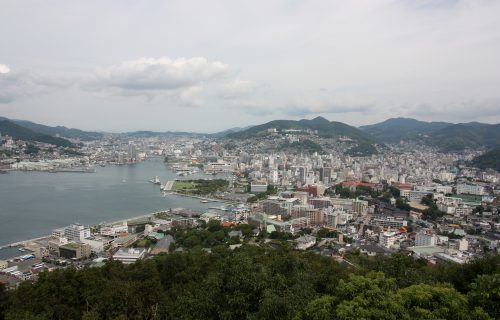
Perched up there, you will find a stunning 360-degree view of Nagasaki. The harbors, shipyard, modern architecture, as well as five designated UNESCO World Heritage Sites. Many of these sites witnessed the Japanese industrial revolution during the Meiji Period.
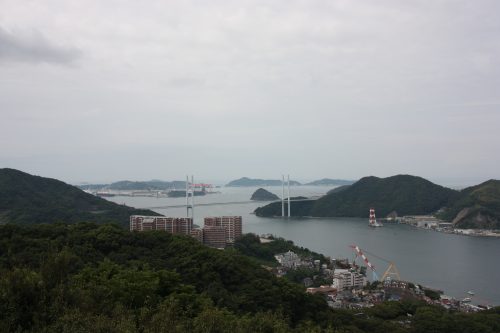
Among them is the former residence of a Scottish merchant. The building was designed in a Western style with functioning electricity. I visited during daytime on a clear day, so I got a clear picture before going down to the city. However, judging by some pictures on the internet, the night view seems just as breathtaking, maybe more!
The Atomic Bomb Museum and Peace Park
Once in the heart of the city, there are two sites which are must-visits: Nagasaki Atomic Bomb Museum and the Peace Park. This museum opened its doors to commemorate the passing of 50 years since the tragedy in Nagasaki. The exhibits bring you right to the heart of the event. And the experience starts with a travel back in time.
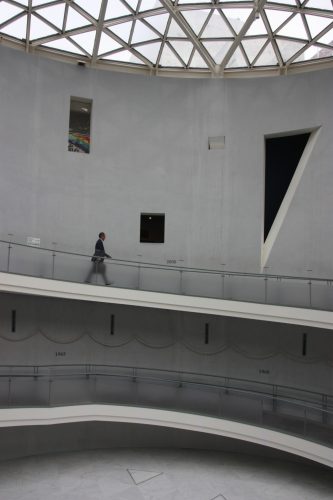
We descend to the basement level to reach the exhibits. The years marked on the walls fly by until stopping at the 9th of August, 1945. The panels show us the incident, filled with many emotional witnesses from this dark chapter of history. Here, you will be able to observe the scars that were left on the city and its inhabitants. The museum is also designed to get a better understanding of the events that led to this tragedy and today’s global nuclear weapon situation.
The experience can be quite intense but does not only focus on the darkest images. The museum also houses two places for hope and healing: the National Peace Hall Memorial and the Peace Park.
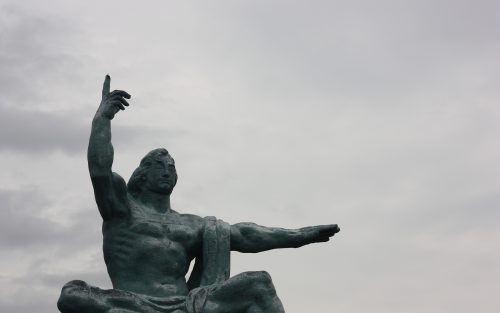
I actually recommend you start with the museum before moving to the park and its beautiful peace statue. You will also witness a few touches of vivid colors with the many paper crane garlands hung in the park here and there, which are symbols of peace.
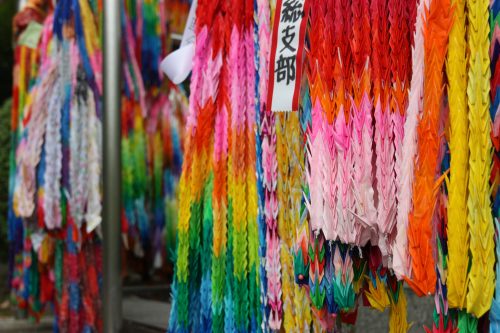
Stroll in the harbor and visit Dejima
Among its other distinguishing features, Nagasaki’s harbor probably ranks highly. This harbor developed as a true open door to the rest of the world. It created international trade relationships as early as the 16th century. Yet, although it is lovely to take a stroll there alongside nice cafés and restaurants, you won’t find a trace of this past history.
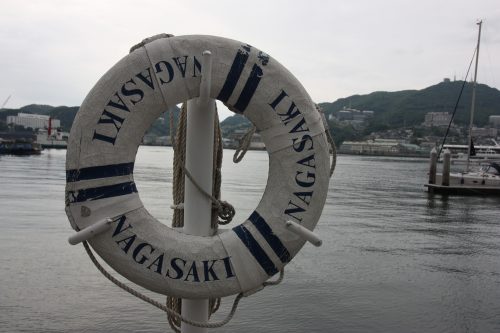
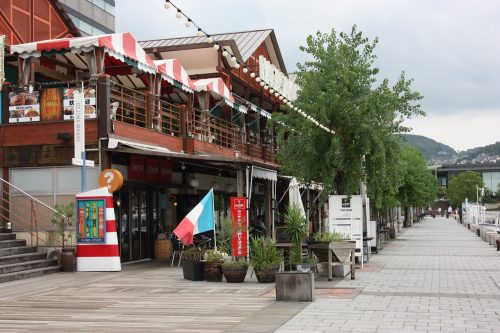
A few minutes walk from there is another highlight. The formerly artificial Dejima Island was once the bastion of trade relationships between Japan and Portugal first, and then the Netherlands. In the political context of national closure and isolation, it was the only place in Japan where foreign traders were allowed to unload their ships full of goods and trade them until 1859.
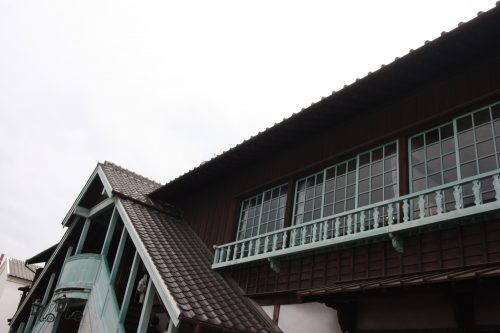
Welcoming Dutch traders for more than two centuries, Dejima was absorbed by the expansion of the city in the 20th century. Designated since the 1920’s as a National Historical Site, important renovation work has been carried out. Thanks to this, you can now visit replicas of the former residences and warehouses of the Dutch traders.
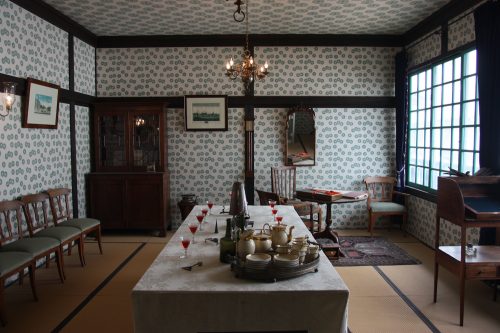
Much more than just a trading sector, Dejima also gave birth to cultural exchanges between Japan and the Netherlands.
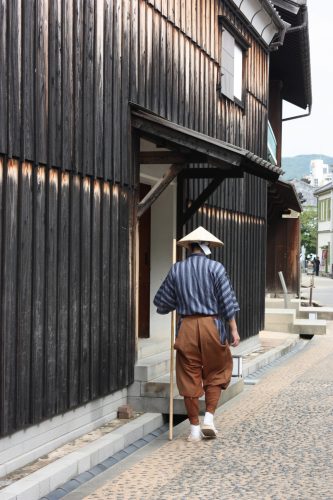
It’s quite a curious and surprising place to visit in Nagasaki. What’s more, you’ll finding the area returning to its original shape as the renovations progress.
Enjoy Lunch at Nagasaki Seaside Park
Continue your stroll along the harbor to Nagasaki Seaside Park. This large stretch of green grass by the sea is where you can go to escape from the city.
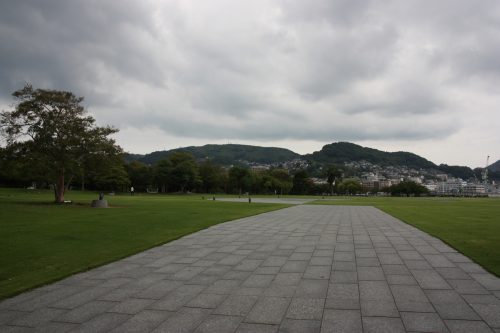
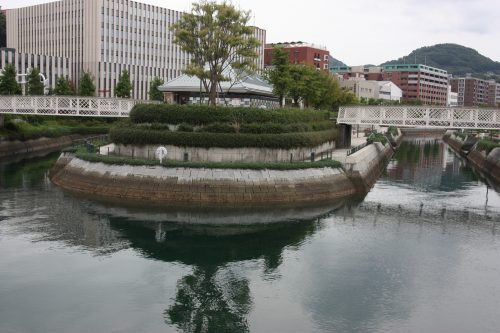
If you miss Western-style food, you will find Nagasaki Winery just around the corner from the park. It’s an Italian restaurant where you can get a nice lunch with nothing too complicated or fancy on the menu. Here you will be served a filling plate of pasta or a good pizza.

To top it all off, you’ll get a nice view of the canals surrounding the restaurant or on the pizza oven. Simple, effective and lovely!
A Brief History of Christianity in Japan
Before we keep going with our next visit, I have to give you a bit of context first. Chances are, just like me, you have never heard of a rather exceptional chapter in Nagasaki’s history. Let’s go back to the 16th century, when the harbor of Nagasaki was opening up to the rest of the world. This was mostly trade ships coming from Europe, along with a few catholic missionaries. These missionaries were very active in the Nagasaki region and started early with the transmission of their religion. This gave birth to a few well-established Japanese Christian communities.
The Japanese government planned to implement a closure policy as of the next century. This included banning the Catholic religion from being practiced and barring European missionaries from entering Japan. Nevertheless, these communities kept practicing their faith in secret, adapting their religious system to this climate of persecution. The ban lasted more than two centuries, during which the Japanese Christians still managed to grow and pass on their faith.
Once the ban was lifted in the 19th century, these communities came out one after the other. Thus, they were finally able to build proper places of worship in their town or village. It is no surprise, then, that we come across so many churches in that region of Japan!
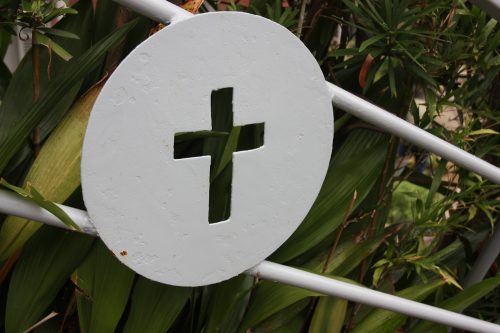
UNESCO has registered 12 of these places, significant during the period from the 17-18th centuries, to its World Heritage Sites since June, 2018.
Oura Church and the Hidden Christians of Nagasaki
Let’s now discover some of these unique historical witnesses: the hidden Christian sites of the Nagasaki region. We begin this historical tour at the Oura Church, where construction started in 1863.
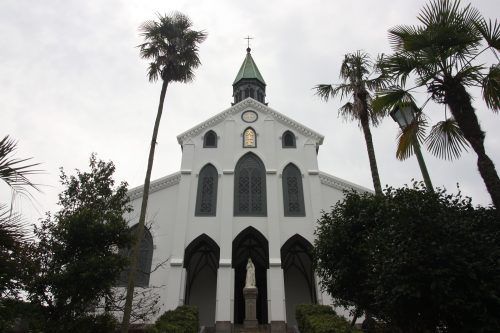
While the ban on Catholic religion was still effective, Japan was starting to reopen to the outside world. An agreement made at the time allowed five countries (USA, UK, Russia, France and the Netherlands) to return to Japan for trade. It is in this context that a few catholic missionaries could come back to the country.
Among them were two French priests who decided to build a church in honor of a group of Christians who were sentenced to death by crucifixion centuries earlier. These were The Twenty-Six Martyrs of Nagasaki. Oura Church played an important part in the history of the hidden Christians of Nagasaki, as it is here that a few of them were discovered in the months following the church opening in 1865.
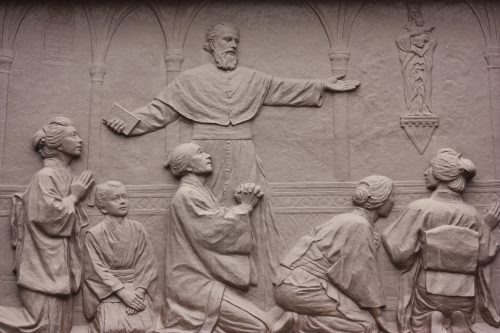
The church you see before you today, although majestic, is not quite identical to the original church. It was expanded once the ban on the Catholic religion was lifted in 1873. It had to undergo additional important repair works following the atomic bomb, mainly on its roof and stained glass windows which were created by French craftsmen.
A magnificent and immaculate church, beautiful in its simplicity both outside and inside. There is nothing overly exuberant, like this statue of the Virgin Mary placed at the entrance.
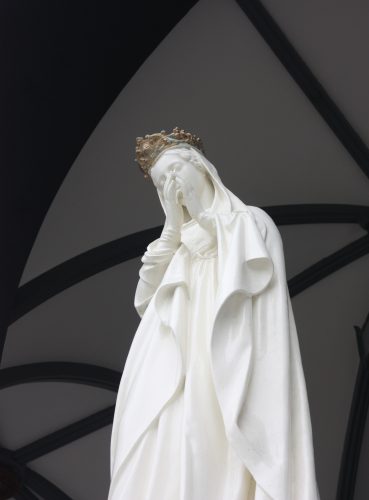
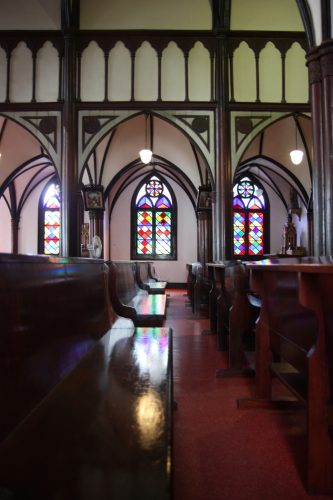
Wood, used heavily inside the church, brings warmth, while the stain glass windows with minimalist designs allow light and colors to come in.
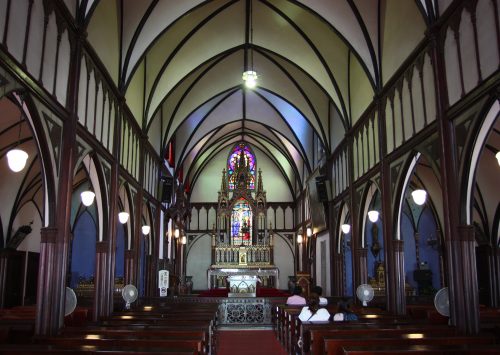
Take your time to visit the site on the right side of the church as well. The former seminary has now been turned into a museum telling the story of the hidden Christians.
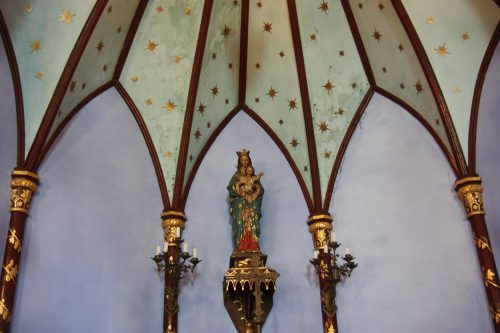
When leaving Oura Church, don’t forget to turn around and admire this unique building one last time, surrounded by palm trees and luscious vegetation. A place this charged with meaning and history is both very interesting and surprising to visit.
Take a Ferry to the Goto Islands
Next, let’s continue following in the footsteps of the hidden Christians of the Nagasaki region by getting on a boat. It will take you to a neighboring archipelago of islands where many early Christians had fled into exile: Goto Islands.
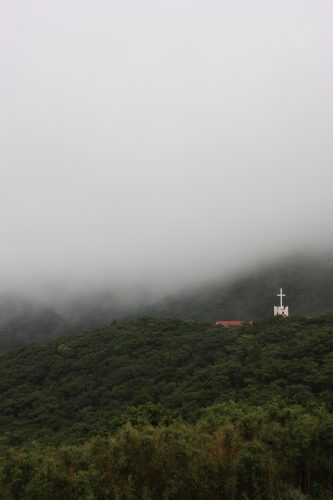
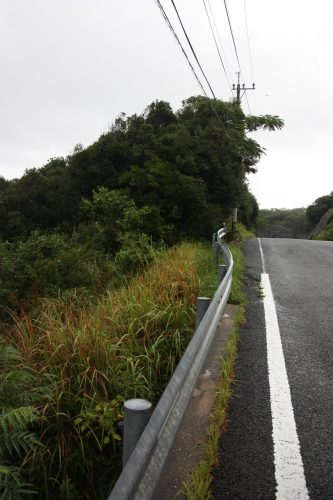
In over an hour by express ferry from Nagasaki Port, you will have left the city well behind you to land on the wild Kami Goto, the Northern part of these islands.
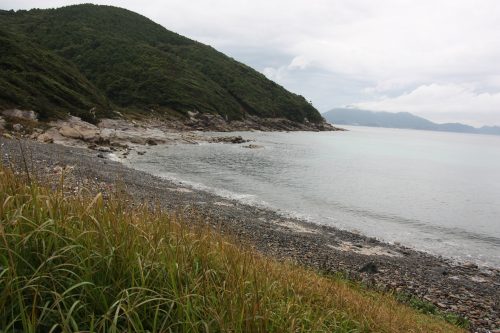
There are around fifty churches in total on the Goto Islands, with 29 of them located in Kami Goto. If you drive around the island (which is actually the best way to get around), you will be able to make several stops on your way to visit them.
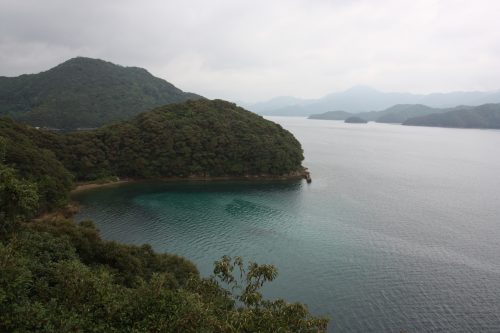
As the island was wrapped in a heavy mist during my visit, I was discovering the churches of Kami Goto in a rather mystical atmosphere.
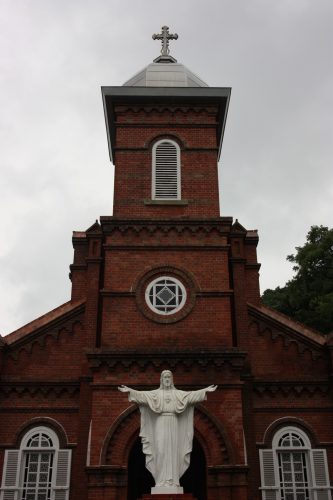
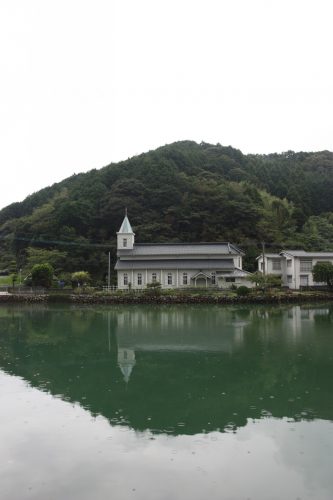
Interestingly, I was spotting details here and there that made them very Japanese. For example, you will have to take your shoes off before entering these churches just like in temples. Additionally, you will be able to keep track of the churches you visited thanks to the signature stamps available at the entrance of each of them.
Kashiragashima Church
The second UNESCO World Heritage Site I discovered was in the former villages of Kashiragashima Island. This island was used in the past for quarantine and had been abandoned until the hidden Christians of Sotome (a former town of Nagasaki Prefecture) decided to settle there in the 19th century.
While the ban on the Catholic religion was still very much effective, they would live under the authority of a buddhist man, in order to better hide their faith. They slowly started growing their community on the entire island, making sure to keep their secret safe. When they received the news that other hidden Christians had been discovered at the Oura Church, they finally revealed their secret and urged the European missionaries to visit them.
It wasn’t long before a first temporary church was then installed in one of the village’s houses. It was later replaced by a proper wooden church built by the locals in 1887, truly marking the end of a life of secrets for this community. In 1905, a cemetery was installed by the sea for the hidden Christians who had passed away. Then, in 1919, the construction of the Kashiragashima Church as we know it today started.
Note that in order to best control the flow of visitors on site, you will not be able to go there by your own means. Instead, you will need to take a free shuttle bus departing every 30 minutes from the Japanese Prefecture Government Office. Make sure to give notice of your visit at least two days in advance, by selecting the date and time you wish to go there (link to website included in the map at the end of the article).
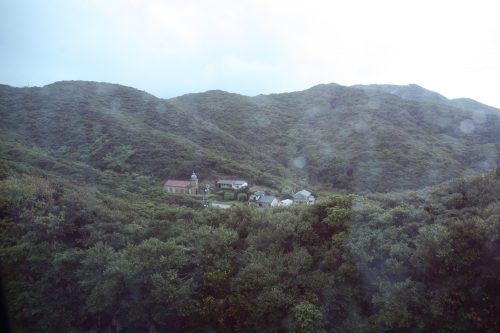
To add to the dramatic character of this isolated church, I arrived with a sky full of clouds and pouring rain.
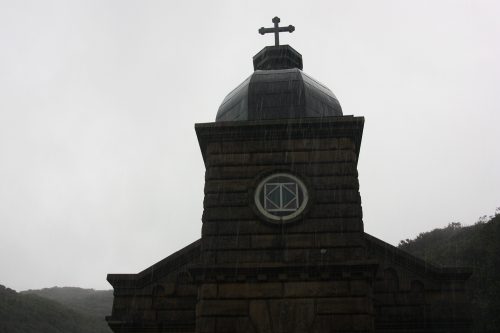
The sandstone exterior of the church, beaten with rain that day, had taken a very dark color.
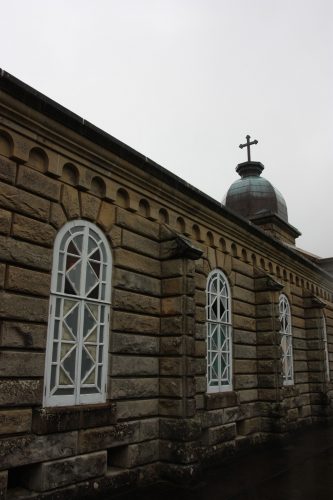
This made the contrast with the inside of the church was all the more surprising! After taking your shoes off, you will enter a building with very soft colors and pastel tones.
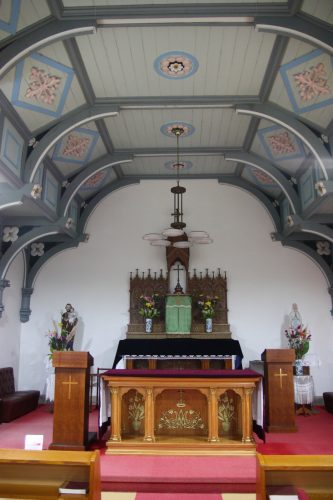
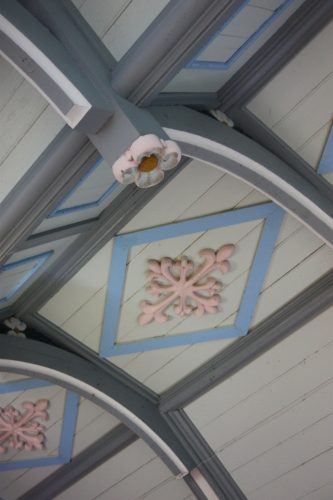
Finally sheltered from rain, an indoor space felt welcoming to me. The space was equipped with a few rows of benches. In a very different style from the Oura Church, it was the simplicity and the warmth of the wood that were particularly striking.
When looking up to the ceiling, you will notice several camellia flowers, the emblem of Goto Islands. An ode to the local flora as a celebration of this community of Christians that was finally allowed to bloom.
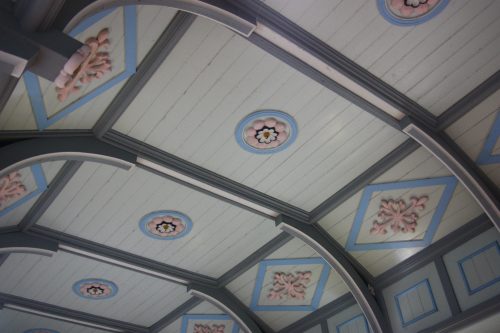
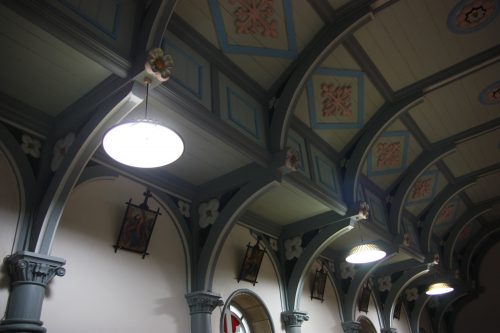
Going out of the church, you will get a view over this now empty and peaceful island, with its steep coastline and seaside cemetery.
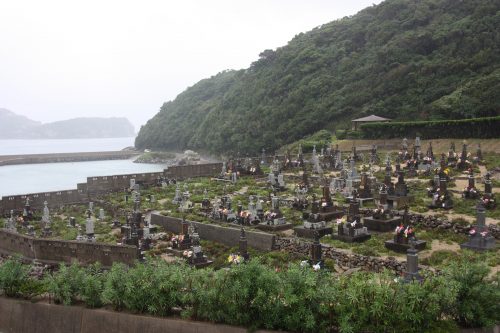
A site which you feel privileged to have visited and from which truly emerges the feeling of relief and freedom the communities of Christians who used to live here must have felt once they could stop hiding.
Hamagurihama Beach
Let’s now change places and atmospheres just a few kilometers from there on Hamagurihama Beach.
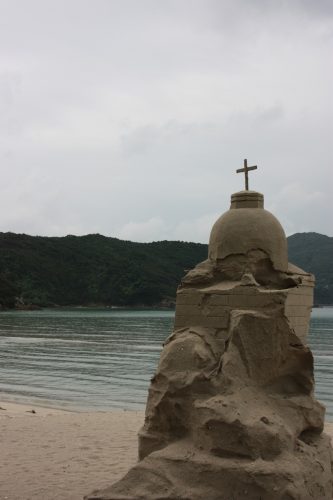
Goto Islands are not only known for churches but also for white sand and crystal clear beaches. And even with a cloudy, rainy weather, the setting is idyllic! Surrounded by a dense vegetation and with a view over the archipelago’s smaller islands in the distance, you start wondering if you are still in Japan. This particular beach has been registered as one of the 100 most beautiful beaches of Japan and attracts many people every summer. Fireworks are also been shot from the water in the summer, creating without a doubt a memorable spectacle.
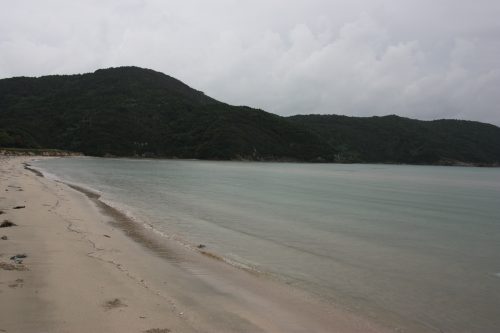
Having the beach all to myself on that day, it is hard to picture it completely full on a hot summer day. And it was mostly frustrating that not even the smallest ray of sunlight would show up and allow me to go for a swim… A good enough reason to come back I guess!
Trying local specialties on Goto Island: Goto Udon
Before taking another boat to reach the Southern part of the archipelago, take a break in one of the local restaurant to taste some of the island’s specialties! Restaurant Yumenzanmai, located just around the corner from Arikawa Port, is a great place to try the famous udon noodles.
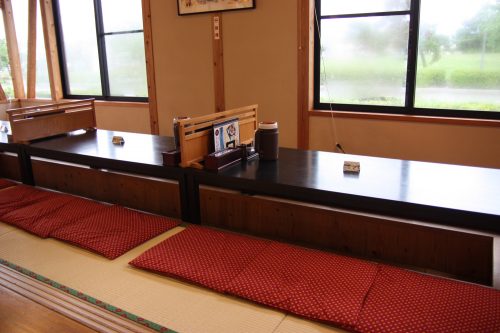
With their slightly gooey and perfectly soft texture, the Goto udon, or Goto Tenobe udon, are one of the most popular dishes of the region. They are part of the three most renowned types of udon noodles in the country and are stretched by hand with a touch of camellia oil, another local specialty. At this restaurant, you will be seated next to the locals to enjoy a comforting and filling bowl of the tasty noodles.
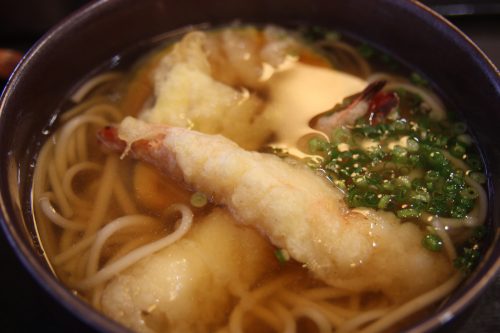
I was choosing to add some shrimp tempura to my bowl, making for the perfect topping.
Visit the Hidden Christian Caves
To keep exploring the Goto Islands, let’s now head towards Fukue Island aboard a taxi boat!
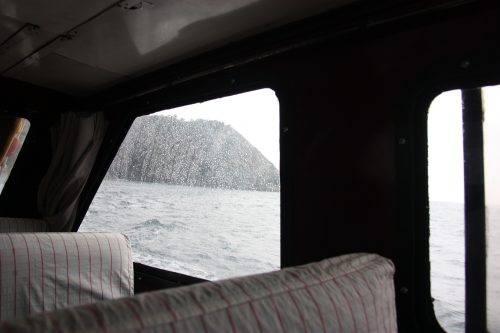
It will take you about one hour for a trip from the north to the south of the Goto Islands, making a stop by another one of the hidden christian sites of the region located on Wakamatsu Island and only accessible by boat.

Back in the 19th century a group of Christians hid there to practice their faith in secret before unfortunately being discovered, reported and then tortured. This cave was renamed the “Christian cave” and a crucifix was erected there in the 1960’s.
Stop at Dozaki Church for a sweet break
There are twelve christian churches in total on Fukue Island. Probably the most famous one of them, the Dozaki Church, is also the first church of the island that was built in a Western style, with red bricks.
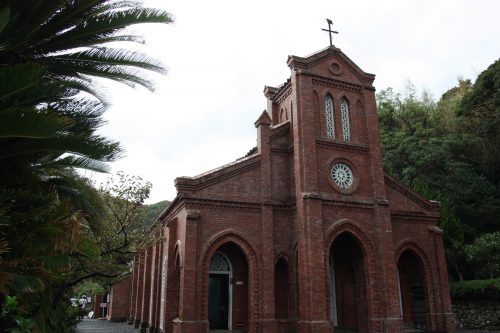
It encapsulates the freedom of worship and the new era that was starting once the ban on christian religion was finally lifted, after two centuries of persecution all over Japan and more specifically on the Goto Islands. Built in 1908, several years after the end of this law, the church seems however quite well hidden and can only be seen once on the spot. The setting is beautiful, in a peaceful creek, with the red bricks of the church contrasting with the surrounding island landscapes.
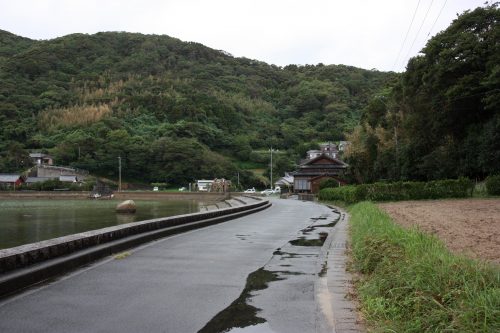
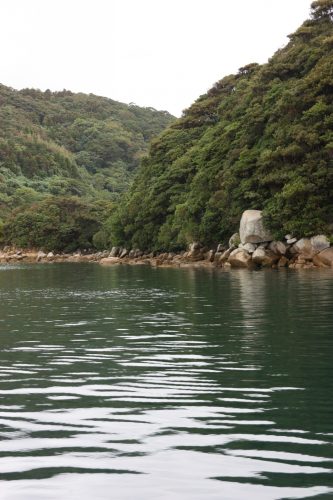
The inside of the church has partly been converted into a museum and exhibits a number of cult objects used by hidden Christians. Among them, you can see a small statue fusing Kannon, the buddhist goddess of compassion, with the Virgin Mary. We also learn that the missionaries who came here to build the church took the initiative of opening an orphanage as well as a convent to welcome the women who were taking care of the orphans. If the location is a bit remote, a mass is still given once a month for the local community of Christians.
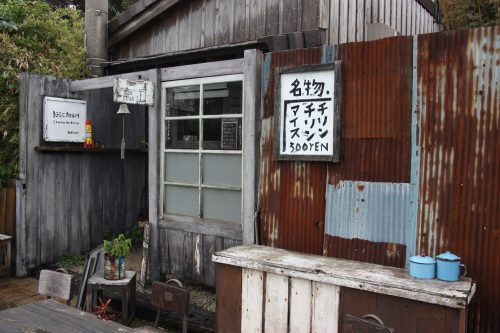
On the path leading to the church, you will notice a small café on the side, Baby Qoo, with a very inviting vintage furniture facing the sea. At the counter, you will meet an old lady with a mischievous twinkle in her eyes who is no other than the owner of the place! At almost 90 years old, she still runs this café with her son where they welcome visitors from all around the world who come to see the church next door. She shows me a small keychain in the shape of koala tied to her hat, which was offered by Australian tourists. Order an ice cream and, if you speak a bit of Japanese (or if you are accompanied by someone who is fluent like I was), she will be happy to start the conversation.
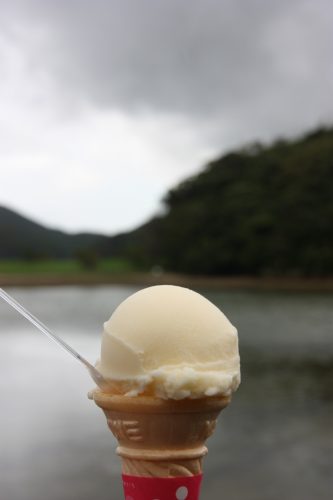
You might learn for example that she arrived on the island when she was 21 years old and got married at the Dozaki Church. I could have stayed here to listen to her stories for hours but other visits were awaiting. I had to leave her and her cute café, but not before asking her for a little souvenir photo.
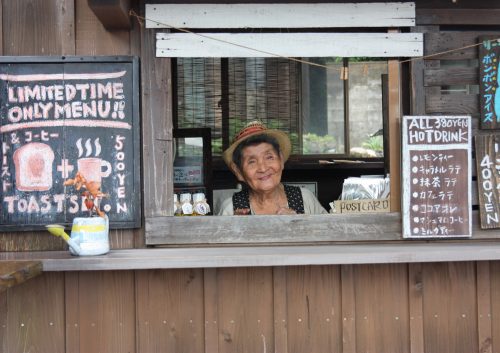
A lord’s former residence and its Japanese garden
For those among you who wish to discover historical sites of Goto Islands other than its churches, go to the ruins of Ishida Castle. Built in the second half of the 19th century, it is one of the last castles to have been built in Japan. The construction work began in 1849 to protect the town from the potential landing of foreign ships and it required more than 50,000 workers and 15 years to complete it in 1863! Surrounded by the sea on three sides, this castle was known for its very strategic position. But as the Meiji era arrived five years later, and with it the end of the feudal system, it was already the end of this castle’s short existence.
Today you can still see the former castle’s moats as well as visit the former residence of the lord who initiated the construction of the Ishida Castle: Moriakira Goto.
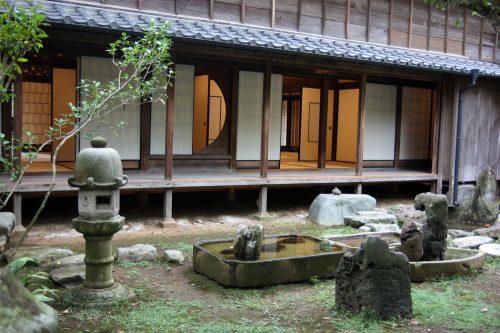
It is an elegant residence designed in a traditional Japanese style and opened on a beautiful garden filled with a rather exotic vegetation.
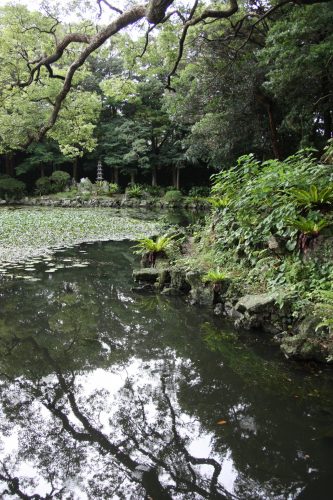
Start your visit by a tour in the garden, inspired by Kinkaku-ji Temple’s garden in Kyoto, where you’ll see an impressive 800 year old tree!
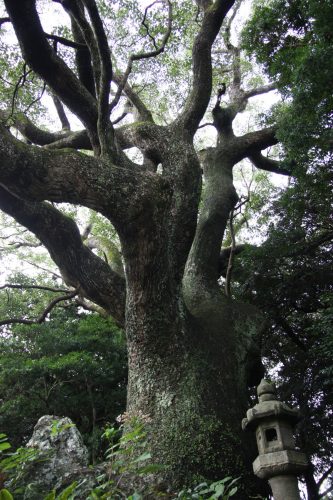
Keep your eyes open, you might spot a few small red crabs staring at you from their hideaway… You can then enter the house, a model of elegance and refinement.
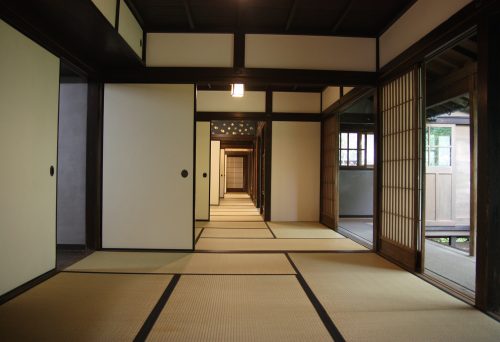
Pay attention to the tapestries and their unique patterns as well as the shoji, sliding panels covered in rice paper. Their shapes and designs are quite original for this type of house and differ from one room to the next.
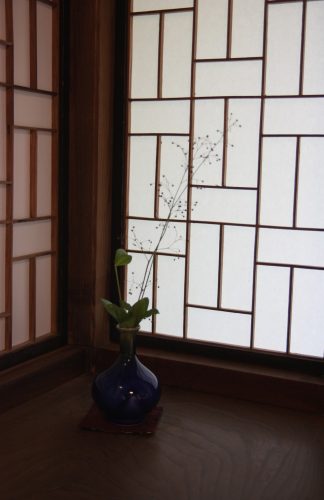
You will also discover the many hideouts of the house, designed to conceal weapons as well as secret doors and passages for the lord and his family to escape in the event of an emergency evacuation.
Myojoin Temple: Pay a Visit to Goto Islands’ Oldest Temple
Let’s end this tour with another religious and spiritual place, the oldest temple of Goto Islands: Myojoin Temple. According to the legend, it has been said that the buddhist monk Kukai went right after he came back from studying in China. He prayed that all the teachings he had received might one day benefit Japan. The next day, he saw there a star shining bright in the sky, myojo or Venus, that he took as a sign his prayer had been heard.
This temple has the specific feature of having a ceiling entirely covered of birds and flowers paintings, 121 of them to be precise.
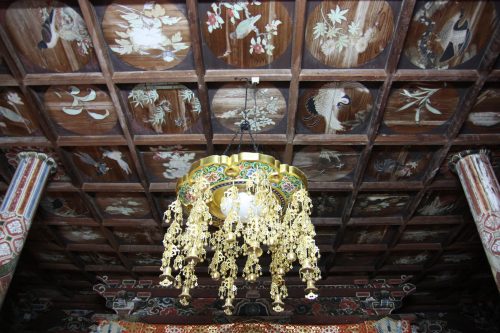
To see this unique architectural feature, don’t hesitate to remove your shoes, push the temple’s door and take the long corridor on the left leading to the back of the main building. This is where you will discover these fascinating and curious paintings, each one of them more refined than the other. Even though you want to get a closer look, watching them from a distance actually maintains a part of mystery to it.
In the end, the highlight of this visit might also be just outside the temple, which is located in the middle of rice fields. A beautiful way to end the exploration of these islands where the incredible and omnipresent natural landscape often gets to be enjoyed one on one, as a privileged spectator.
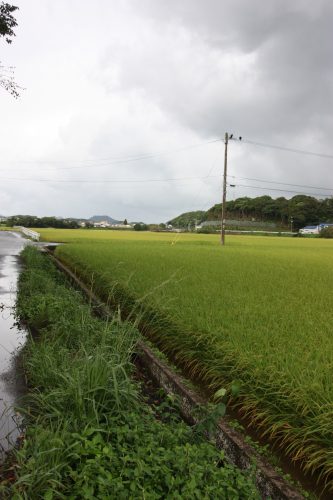
Spend the night at the Margherita Hotel
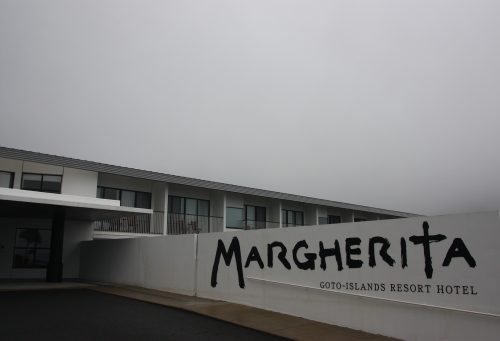
To spend the night on one of these islands with mystical charm, you can book a room at the Margherita Resort Hotel, located in the Northern part, in Kami Goto Island.
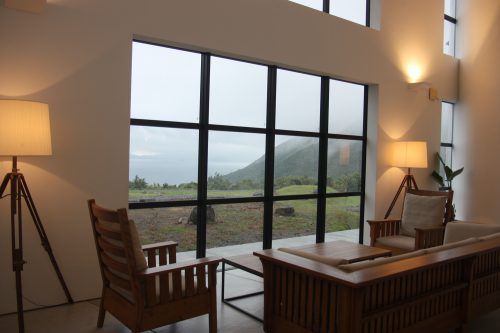
Just like the number of churches that can be counted on the island, the hotel has 29 rooms in total. Offering on one side or the other a wonderful panorama by the sea and the island’s steep coastline, your room will either offer you a view of the sunset or the sunrise. A small card will be left in your room, indicating the exact timings to best enjoy the view.
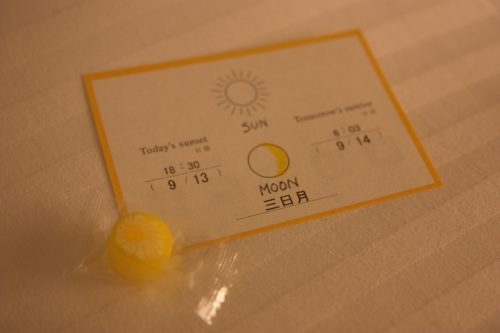
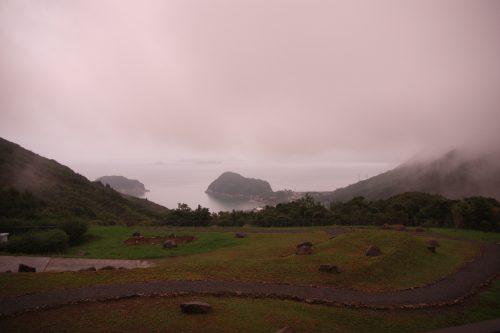
Everything is designed to enjoy the natural setting to the fullest: large bay windows at reception and in bedrooms, a covered terrace close to the spa, a garden overlooking the sea…
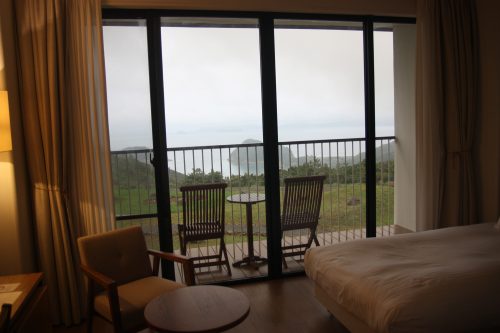
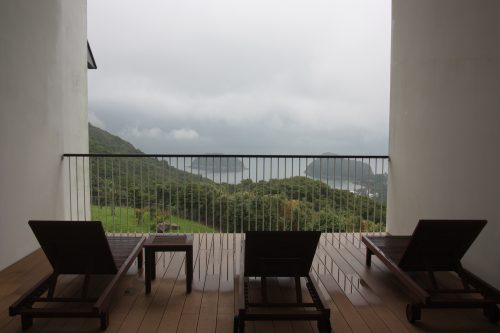
If like me, the sun is not out during your stay, you will also find ways to enjoy cocooning indoors, in the tastefully arranged library or in one of onsens.
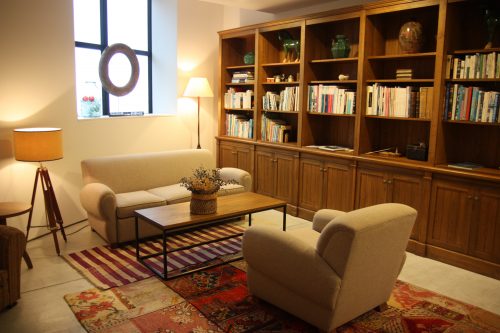
The restaurant, Sora To Umi No Jujiro (“Where Sky and Sea Meet”), is also open to guests who are not spending the night here.
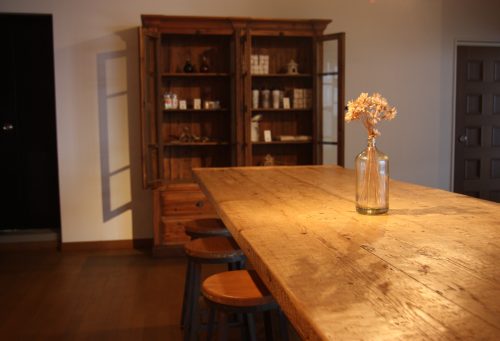
In a rather lively atmosphere (a packed room on a weeknight!), both chic and casual, you will be served an Italian-style cuisine: antipasti to share, pasta, olive oil, and focaccia…
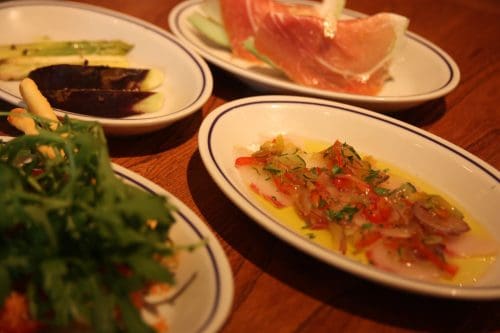
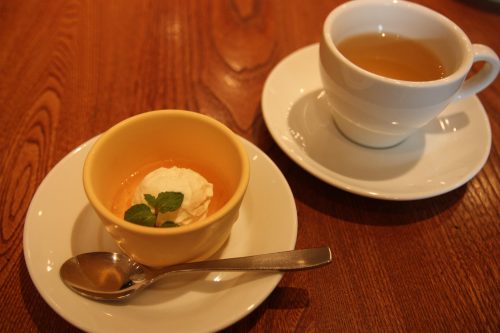
And a delicious yuzu tiramisu to top it all off. As for breakfast, you will be able to choose a Western or Japanese one, both of which are more than generous!
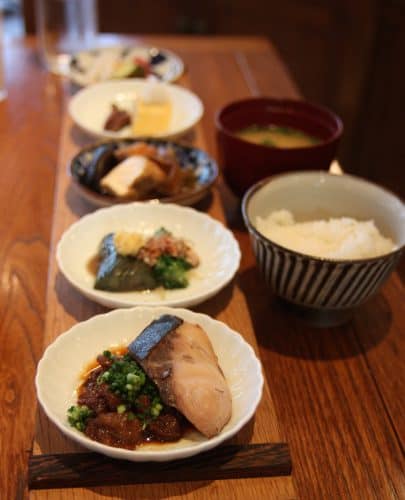
Nagasaki Prefecture in a few addresses
While the Goto Islands have been a true favorite of mine, please note however that without speaking a word of Japanese and without a driver’s license, visiting them might be a bit challenging at times. The island is sparsely populated and quite wild, so make sure to plan your trip before visiting!














